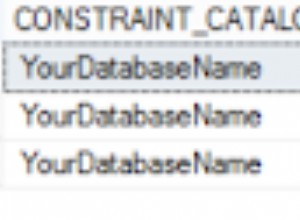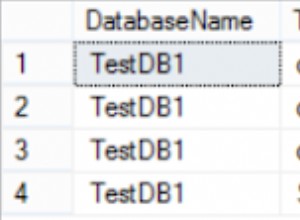Anda tidak dapat mengurutkan array asosiatif berdasarkan nilai, tetapi Anda harus mengonversi data ke beberapa struktur data lain dan membuat pengurutan di sana. Cara termudah adalah mengonversi ke larik asosiatif lain tempat kunci dan nilai bertukar tempat, tetapi itu mengharuskan nilai kunci Anda juga harus unik.
Di bawah ini adalah contoh yang disesuaikan dengan kasus Anda dari Mengurutkan Koleksi PL/SQL . Silakan periksa artikel itu untuk detailnya.
/* The sorting is done with SQL thus these types have to be SQL types. */
create type sortable_t is object(
continent varchar2(32767),
population number
);
/
create type sortable_table_t is table of sortable_t;
/
declare
type continent_population_t is table of pls_integer index by varchar2(32767);
continent_population continent_population_t;
i varchar2(32767);
sorted sortable_table_t := sortable_table_t();
begin
/* Populate original data. */
continent_population('Australia') := 30;
continent_population('Antarctica') := 90;
continent_population('UK') := 50;
continent_population('USA') := 50;
/* Convert to a helper data type that is used for sorting. */
i := continent_population.first;
while i is not null loop
sorted.extend(1);
sorted(sorted.last) := new sortable_t(i, continent_population(i));
i := continent_population.next(i);
end loop;
/* Show that the content is not sorted yet. */
dbms_output.put_line('Unsorted:');
for j in sorted.first .. sorted.last loop
dbms_output.put_line(sorted(j).continent || ' = ' || sorted(j).population);
end loop;
/* Sorting with SQL. */
select cast(multiset(select *
from table(sorted)
order by 2 asc, 1 asc)
as sortable_table_t)
into sorted
from dual;
/* Show that the content is now sorted. */
dbms_output.put_line('Sorted by value:');
for j in sorted.first .. sorted.last loop
dbms_output.put_line(sorted(j).continent || ' = ' || sorted(j).population);
end loop;
end;
/
Cetakan:
Unsorted:
Antarctica = 90
Australia = 30
UK = 50
USA = 50
Sorted by value:
Australia = 30
UK = 50
USA = 50
Antarctica = 90




